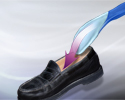Heel pain
Pain - heel
Causes
Heel pain is most often the result of overuse. However, it may be caused by an injury.
Your heel may become tender or swollen from:
- Shoes with poor support or shock absorption
- Running on hard surfaces, like concrete
- Running too often
- Tightness in your calf muscle or the Achilles tendon
- Sudden inward or outward turning of your heel
- Landing hard or awkwardly on the heel
Conditions that may cause heel pain include:
-
Swelling and pain in the
Achilles tendon
Achilles tendon
Achilles tendinitis occurs when the tendon that connects the back of your leg to your heel becomes swollen and painful near the bottom of the foot. ...
Read Article Now Book Mark Article -
Swelling of the
fluid-filled sac
(bursa) at the back of the heel bone under the Achilles tendon (bursitis)
Fluid-filled sac
Bursitis of the heel is swelling of the fluid-filled sac (bursa) at the back of the heel bone.
Read Article Now Book Mark Article - Bone spurs in the heel
- Swelling of the thick band of tissue on the bottom of your foot (plantar fasciitis)
- Fracture of the heel bone that is related to landing very hard on your heel from a fall (calcaneus fracture)
Home Care
The following steps may help relieve your heel pain:
- Use crutches to take weight off your feet.
- Rest as much as possible for at least a week.
- Apply ice to the painful area. Do this at least twice a day for 10 to 15 minutes. Ice more often in the first couple of days.
- Take acetaminophen or ibuprofen for the pain.
- Wear well-fitted shoes.
- Use a heel cup, felt pads in the heel area, or shoe insert.
- Wear night splints.
Your health care provider may recommend other treatments, depending on the cause of your heel pain.
Maintaining flexible and strong muscles in your calves, ankles, and feet can help prevent some types of heel pain. Always stretch and warm-up before exercising.
Wear comfortable and well-fitting shoes with good arch support and cushioning. Make sure there is enough room for your toes.
When to Contact a Medical Professional
Call your provider if your heel pain does not get better after 2 to 3 weeks of home treatment. Also call if:
- Your pain is getting worse despite home treatment
- Your pain is sudden and severe
- You have redness or swelling of your heel
- You cannot put weight on your foot
What to Expect at Your Office Visit
Your provider will perform a physical exam and ask questions about your medical history and symptoms, such as:
- Have you had this type of heel pain before?
- When did your pain begin?
- Do you have pain upon your first steps in the morning or after your first steps after rest?
- Is the pain dull and aching or sharp and stabbing?
- Is it worse after exercise?
- Is it worse when standing?
- Did you fall or twist your ankle recently?
- Are you a runner? If so, how far and how often do you run?
- Do you walk or stand for long periods of time?
- What kind of shoes do you wear?
- Do you have any other symptoms?
Your provider may order a foot x-ray. You may need to see a physical therapist to learn exercises to stretch and strengthen your foot. Your provider may recommend a night splint to help stretch your foot. At times, further imaging, like CT scan or MRI may be needed. Surgery may be recommended in some cases.
References
Ferri FF. Plantar fasciitis. In Ferri FF, ed. Ferri's Clinical Advisor 2016 . Philadelphia, PA: Elsevier; 2016:970-970.
Kadakia AR. Heel pain and plantar fasciitis: hindfoot conditions. In: Miller MD, Thompson SR, eds. DeLee & Drez's Orthopaedic Sports Medicine . 4th ed. Philadelphia, PA: Elsevier Saunders; 2015:chap 119.
McGee DL. Podiatric procedures. In: Roberts JR, ed. Roberts and Hedges' Clinical Procedures in Emergency Medicine . 6th ed. Philadelphia, PA: Elsevier Saunders; 2014:chap 51.
Murphy GA. Disorders of tendons and fascia and adolescent and adult pes planus. In: Canale ST, Beaty JH, eds. Campbell's Operative Orthopaedics . 12th ed. Philadelphia, PA: Elsevier Mosby; 2013:chap 82.
Review Date: 3/10/2016
Reviewed By: C. Benjamin Ma, MD, Professor, Chief, Sports Medicine and Shoulder Service, UCSF Department of Orthopaedic Surgery, San Francisco, CA. Also reviewed by David Zieve, MD, MHA, Isla Ogilvie, PhD, and the A.D.A.M. Editorial team.

